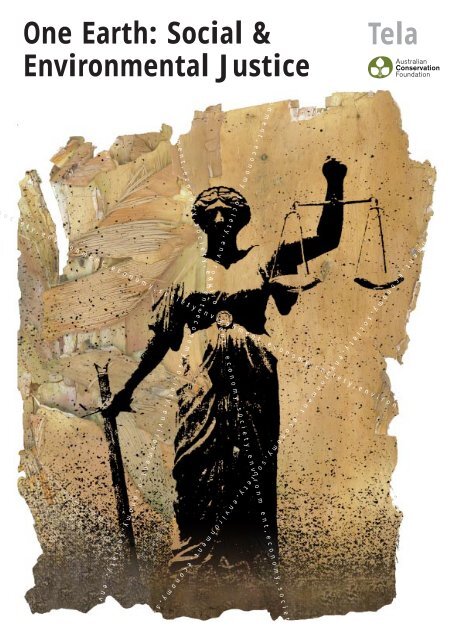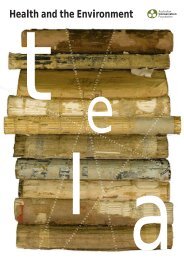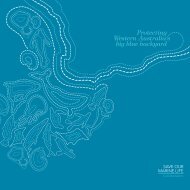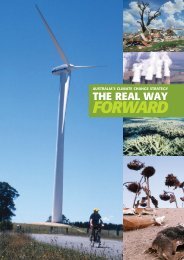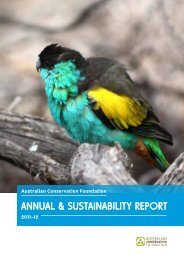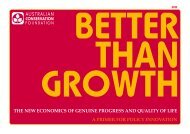Social & Environmental Justice - Australian Conservation Foundation
Social & Environmental Justice - Australian Conservation Foundation
Social & Environmental Justice - Australian Conservation Foundation
- No tags were found...
You also want an ePaper? Increase the reach of your titles
YUMPU automatically turns print PDFs into web optimized ePapers that Google loves.
environment,economy,society,enviro nent economy,society,environm ent,economy,society,eociety,environment,economy,societyenvironment,economy,society,environment,environment,economy,society,environment economy,society,environment,economy,society, enviroenvironment,economy,society,env ronment,economy,society,environment,economy,sociOne Earth: <strong>Social</strong> &<strong>Environmental</strong> <strong>Justice</strong>Tela
onment,economy,society,environment,economy,society,environment,economy,Tela is a series devoted to the explorationof the relationships between the environment,economy and society.Editorial BoardNeil BlakeDr Hugh SaddlerAssociate Professor Leonie SandercockProfessor Emeritus Ralph Slatyer ACMichael KrockenbergerProfessor Emeritus David Yencken AO (chair)All papers are peer reviewed before publication.The Health and the Environment paperis jointly sponsored by:<strong>Australian</strong> <strong>Conservation</strong> <strong>Foundation</strong><strong>Australian</strong> Council of <strong>Social</strong> ServiceThe views expressed in this paper are those of the authorsand do not necessarily represent the views or policies ofthe sponsoring organisations.In keeping with editorial policy for this series, references arenot provided in the text, but the main sources are indicatedunder ‘Further reading’ at the conclusion of this paper.The support of The Myer <strong>Foundation</strong> and the Mullum Trust forthe Tela series is gratefully acknowledged.my,society,environment,economy,society,environment,economvir
tela: social & environmental justice issue 2 november 1999pageiiAbstract page 11 Introduction page 22 Injustice in and to the environment page 53 <strong>Environmental</strong> justice in an <strong>Australian</strong> context page 164 Ecological justice page 205 Towards new principles page 23
AbstractOur living environment is critically important to our quality of life. It is unjust and unfairthat the risks and costs of production are loaded on to the living environments of somepeople, while others enjoy the benefits but avoid the costs. In a wider sense, too, wehumans are responsible for the environment, because the environment is the living spaceof all other creatures.page1In exploring the connection between social justice and environmental responsibility,we develop two related concepts: environmental justice and ecological justice. The firstconcerns the fair distribution of ‘good’(attractive, safe) and ‘bad’ (ugly, hazardous)environments among humans. The second concerns the just relationship between humansand the natural world. The paper begins by examining four case studies: the siting of toxicand hazardous chemical facilities in Melbourne, the logging of old growth forests in EastGippsland, uranium mining at Jabiluka in the Northern Territory, and Australia’s current‘greenhouse’ policy. These cases reveal, we argue, prima facie evidence of environmental andecological injustice.‘Combining social justice with environmentalresponsibility involves two basic concepts:environmental justice and ecological justice.’While environmental justicecentres on the welfare ofhumans, ecological justicetakes a wider perspective.Conserving the integrity of theplanet means expanding further the sphere of morality. Our argument rests on the notion thatwe care for non-human nature primarily because we value ourselves by caring for the planet.In the final part of the paper we argue that the moral foundation of today’s politics andeconomy is too restricted to encompass humanity’s concern for society and the environment.We argue for a three level expansion of the idea of justice. We conclude that social andenvironmental justice are closely connected. A shift is needed in thinking about <strong>Australian</strong>environmental and social policy to demonstrate the connection. In the United States the rightto environmental justice is now law. We must consider what Australia can do during the nextcentury to reconcile economic and ecological globalisation in order to achieve social,environmental and ecological justice. We propose that principles of environmental justice beincorporated in legislation, and an immediate public inquiry be held into environmental andecological justice in Australia.
Introductionpage2Do you live in a ‘leafy suburb’ with clean air, in a well maintained and harmonious urbanor rural landscape? Is affordable food always in the supermarket? Or is the surroundingland contaminated with toxic chemicals, the air polluted and the neighbouring land usesthreatening? Do you live at risk of extreme climatic events: floods, droughts, plagues andfamine? Our living environment is critically important to our quality of life. It is not fair thatsome reap the benefits of economic growth while others pay heavy environmental costs.It is not fair that some people living today enjoy the benefits of irresponsible and unthinkinggrowth while people living in future, our children and grandchildren, are left to pay the costs.But that is not all. For today we understand that ‘the environment’ includes not only ourown living space but the habitats of all living creatures. We have a responsibility not only toourselves, to humankind, but to the other occupants of the planet. At stake in today’s globalprocesses of production are both human living space and the habitats of all species.‘A Fair Go’ is a core value for <strong>Australian</strong>s. ‘A Fair Go’ is about social justice. But social justicemust include — and indeed has in the past included — the environment. Likewise debatesabout the environment must include the value of social justice. Saving the environment is notprimarily about communing with some aesthetic vision of ‘nature’ but about distributing fairlythe benefits our earth provides and, in a very real sense, about saving ourselves as a species.This paper explores how questions of the environment and social justice are connected.We combine the ideas of environmental responsibility with social justice in two interlockingconcepts: environmental justice and ecological justice — aspects of justice as concerns the Earthand our place in it.‘<strong>Environmental</strong> justice concerns thefair distribution among humans ofgood and bad environments.’<strong>Environmental</strong> justice refers to the distributionof environmental quality among people.We experience our own small part of ‘nature’which we look out on, interact with, breathe,eat, drink, touch, hear and smell. This is ourenvironment. It can be very good for us or very bad. Some people live and work in delightfulenvironments. Others exist in oppressive, ugly and hazardous environments. Environmentsmay thus be part of our riches or our poverty. <strong>Environmental</strong> justice has most often beendefined in terms of environmental rights. But justice can also be understood in terms ofmeeting basic needs. This is what John Rawls has called the conditions of ‘background justice’as opposed to the procedural rules for arriving at just decisions.
One EarthThe Rio Declaration of 1992, signed by Australia, states that, ‘The right to developmentmust be fulfilled so as equitably to meet developmental and environmental needs of presentand future generations’ (Principle 3). Thus we have no right to rob our descendants of theenvironmental quality we ourselves enjoy today, and we must share out that quality fairly. Thisconcept is about ‘justice in the environment’. The right to environmental justice became USlaw both in the rules of the federal <strong>Environmental</strong> Protection Authority and in the President’sexecutive order 12898.Ecological justice concerns the relationshipbetween humans and the rest of the naturalworld, the planet we belong to. This is notjust a matter of altruistic concern for othercreatures but of how we view ourselves: whowe truly are. Finding justice is a properly human occupation. We give the environmentmeaning and it gives us meaning. The meaning of each person’s existence depends upon a‘world’ that wraps around the person which is neither bounded by the institutional barriers ofproperty and the territory of states nor is infinite in extent. Environments overlap and areunavoidably shared. In so far as we define ourselves as persons in relationships, one of themost important relationships is with our planet and its magnificent panoply of species.This relationship has been defined by feminists as one of ‘care’, indeed care is arguablythe basis of all ethics. Principle 7 of the Rio Declaration reads ‘States shall cooperate in aspirit of global partnership to conserve, protect and restore the health and integrity of theEarth’s ecosystem’. We speak here of ‘justice to the environment’. Insofar as ‘sustainabledevelopment’ has been inscribed in European law (and ‘ecological sustainability’ has alsobeen incorporated into the law of New South Wales and Queensland), so also has theprinciple of ecological justice.Stated briefly, our view of justice involves sixmain arguments. First, the claim is rejectedthat justice can be reduced to a simpleformula providing a universal foundationfor judgements. <strong>Justice</strong> will always be, andshould always be contested. Second, there is a continuum in the moral value accorded to thenatural world of which humans are part. There is no fundamental ethical distinction betweenthe human and non-human.page3‘Ecological justice is concerned withresponsible relationships between humansand the non-human natural world.’‘<strong>Environmental</strong> justice involves processbecause the procedures we design must beinfused with moral purpose.’
tela: social & environmental justice issue 2 november 1999page4Third, questions of ethics arise from how we humans see ourselves related to others: inrelations of care, kindness, respect and fairness. Fourth, our world is structured, so that eventhough there are no absolute distinctions in nature, there are ‘layers’ or ‘levels’ of existence.Fifth, for prudential reasons we must pay attention to justice of outcome over justice ofprocedure, though both must be respected. Finally, for justice to be done, politicalinstitutions — especially global institutions — must in time be changed to allow a muchwider range of ethical ideas and voices to be heard and to have practical impact in the world.These arguments are fully addressed elsewhere (in the book <strong>Justice</strong>, Society and Nature) and wecan only touch on them briefly in this paper.We want to bring into clearer focus the two aspects of justice: environmental and ecological.First some prima facie examples of injustice in and to the environment are considered whichare of particular relevance to Australia. We then show how the idea of environmental justiceapplies to Australia. Next we approach the question of ecological justice. Briefly outlined arethe different ways in which others have approached this question; and reasons are discussedwhy it is so important for Australia. In the final section issues of principle are addressed,pointing out the shortcomings of the moral framework determining public policy today.We suggest some moral ‘rules of thumb’ for approaching environmental and ecologicaljustice and the idea of ‘levels’ of justice is introduced. In conclusion we review briefly whatneeds now to be done to further the cause of environmental and ecological justice.
Injustice in and to the environmentLet us begin by considering some examples of apparent injustice, cases where policy processeslead to seeming unfairness in the distribution of environmental benefits and burdens, and toabuses of the natural world. We start with two examples of local injustice: the siting of toxicand hazardous industrial facilities in Victoria, and the logging of old growth forests innational parks. We then outline two examples of ‘global’ injustice: the mining of uraniumadjacent to Kakadu National Park, and Australia’s current climate policy.page5Siting of toxic and hazardous waste facilities in VictoriaIt has long been argued that capitalist cities are ‘unfairly structured’. In Hugh Stretton’swords, ‘the structure of cities distributes costs and benefits as drastically as the structure ofincome does’. For a variety of reasons, some parts of cities come to enjoy a pleasant and safeenvironment, while others have a degraded environment which poses risks to health. Theformer are occupied predominantly by the wealthy, the latter by the poor. But environmentsare not just the passive reward of wealth and the price of poverty. Environments activelyperpetuate both, and thus contribute to continued spatial division between rich and poor.The settlement of Australia dispossessed and brutalised indigenous <strong>Australian</strong>s and todaymost Aborigines continue to suffer discrimination and disadvantage. However, <strong>Australian</strong>cities have not been shaped by the forms of racism which created the inner urban ‘ghettos’in American cities. Nor have Australia’s major cities suffered from the imprint of smokestackindustrialisation which continued to shape post-war reconstruction in metropolitan Europe.There is in <strong>Australian</strong> cities much more of a mix of rich and poor people in better and worseurban environments. Nevertheless it is well known that in broad terms the Western suburbsof Sydney and Melbourne suffer from environmental degradation as a result of the historyof industrial location. Relative poverty and environmental risk tend to go hand in hand. Thistendency is evident in the location of industrial sites where toxic chemicals are processed,and where the chemical inputs and waste outputs are stored. This point was underlined byreports (The Age, 14th Dec 1998, page 3) that about half a million cubic metres of hazardoussoil from Melbourne’s major construction projects in 1997 and 1998 had been dumped atthirteen sites in the West and North, and one in the South East.‘Relative poverty and environmentalrisk tend to go hand in hand.’
tela: social & environmental justice issue 2 november 1999page6During the 1990s attempts to limit the tendency to environmental degradation and increasedrisk in Melbourne’s Western suburbs were thwarted by arguments put to governments thatthe health of the economy demands that industry be given a free rein. For example in 1992,under the threat of disinvestment, the Labor Government in Victoria gave permission for theMobil oil company to expand its Altona petrochemical refinery in Melbourne’s West.Considerable public concern was expressed about the safety of the refinery operations, whichare situated close to residential areas. Following a public inquiry into the issue, the (Labor)government capitulated to the company and gave permission for the development to proceedin accordance with its demands.The risks of toxic and flammable chemical storage were demonstrated in 1991 when a massiveblaze occurred at the Coode Island chemical storage depot at the confluence of the Yarra andMaribyrnong rivers within a kilometre of densely populated Footscray. A cloud of toxic smokewas released which drifted over inner Melbourne. The then Labor State Government vowedto relocate the Coode Island depot to a site more distant from human settlement. The firstchoice for relocation, West Point Wilson; was rejected when the Federal Government insistedthat the proposed site be used for an armaments complex. The subsequent proposal torelocate the depot to a more remote location at Point Lillias ran into sustained oppositionbecause the site includes a wetland protected under the international Ramsar Convention.The site is also a habitat of one of Australia’s most endangered species, the orange belliedparrot, and contains shell middens of cultural significance to local Indigenous people.In April 1998 the (Coalition) State Government announced its intention to grant permissionfor the development of the Point Lillias site, and also for two toxic waste landfills in formerquarries at Werribee and Niddrie, both in Melbourne’s Western suburbs. The CommonwealthGovernment gave permission for 20 hectares to be excised from the Ramsar protected site(only the second such instance in the life of the Convention). Both landfill proposals haveattracted much local opposition. Residents argue that both the sites themselves and thetrucking of the chemicals to the sites increases local risks and further degrades the environment.To the publicly expressed fury of the former Premier of Victoria, Werribee counciland CSR have now listened to resident concerns and agreed to abandon the toxic dump.
Figure 1. Rates of unemployment in Melbourne and the locationof toxic chemical sites (Melbourne Statistical Division by Postal Area).page712.4 – 27.8% (50)9.0 – 12.4% (38)7.1 – 9.0% (55)5.5 – 7.1% (71)Source: 1996 Census,<strong>Australian</strong> Bureauof Statistics.Melbourne StatisticalDivision by Postal Area.0 – 5.5% (41)Niddrie QuarryCoode IslandCaltex NewportDandenong OffensiveIndustry SoneCSR Waste FacilityThe above cases do not constitute examples of environmental racism (comparable withsimilar cases in the USA — see below), yet they are cases of environmental abuse andinjustice. Threats to the safety of the local environment occur in areas which, because of theirindustrial history, already suffer from degradation. They are also close to areas with a higherthan average incidence of economic and social disadvantage (see Figure 1). In a real sensethese places have been selected to bear the immediate social and environmental costs ofproduction. As was demonstrated by the Coode Island fire, an accident involving chemicalscan affect a much more widespread area than the immediate locality. Most importantly, theseexamples show why it is so important for environmentalists to work closely with those whohave traditionally pursued the cause of social justice to find solutions which are both sociallyfair and environmentally responsible. Much more urgent attention needs to be given toreducing and eventually eliminating the use of toxic chemicals in production processes.
tela: social & environmental justice issue 2 november 1999page8The continued siting of toxic industries close to places occupied by poorer people illustratesthe spatial distributional aspect of environmental injustice in which poorer communities arecontinually being loaded with additional environmental risks.Logging of old-growth forests in East Gippsland<strong>Justice</strong> to future generations demands ‘ecologically sustainable development’. One canargue over the definition of ‘development’ and ‘sustainable’ but what is undeniable is thatjudgements must be made in favour of some forms of development and against others,and further, that those judgements can no longer be left to individualised producers andconsumers interacting in markets.There are two timber industries in Australia. One industry logging native forests has beenestablished for over a hundred years. Families of loggers who have grown up in the ruralenvironment are supported by this industry. A more recent profitable addition is theconversion of surplus trees into woodchips for the Japanese paper industry. These ‘surplus’trees, however, are the habitat of many animals. The other timber industry is the intensivecultivation of plantation timber. Pine plantations have been cultivated for many years forproduction of softwood for building timber. More recently, however, cleared agricultural landhas been planted with fast growing gum trees (eucalyptus) to supply the home and exportwoodchip market. Some <strong>Australian</strong> paper mills have now planted forests to keep them wellsupplied with the raw material for pulp. Plantation forests are arguably better for the landthan the European-style agriculture that the plantations replace. New forests can be managedto introduce a degree of biological diversity and need not become monocultures.The logging industry is damaging to the environment, plantation forestry is potentiallyecologically sustainable provided that it does not imply any clearing of native forests. Newforests also increase the capacity of Australia’s ‘carbon sink’ (absorbing greenhouse gases).The plantation timber industry has the capacity to supply much of the existing demand bothfor logs and woodchips within a few years. Logging and woodchipping of ancient forests isin one sense, ‘sustainable’ because the trees are replanted, as required by law. But virginforest is slowly being converted into plantation forest. In a very important sense this practiceis unsustainable because it destroys the habitat of rare species which live in and around theold and often decaying trees.
One EarthTraditional forestry practice, which involves massive human intervention, is not goodconservation practice for old growth forests. For the past several years the <strong>Australian</strong>government has devised strategy after strategy to allow logging and woodchipping tocontinue, while trying (unsuccessfully) to placate the environmentalists with patchworkplans for forest conservation.page9‘Governments have used social justice arguments selectivelyto support a dying and environmentally damaging industry.’Of course forestry is very important to the economies of a number of rural communities inEast Gippsland. In a sample survey carried out in 1996 about a quarter of those employedworked in the timber and related industries (reported in the East Gippsland ComprehensiveRegional Assessment, <strong>Social</strong> Report, p. 54). There is a very real issue of social justice formany rural communities when their economic mainstay becomes economically or ecologicallyunsupportable. This is an issue of managing change which both environmentalistsand governments must address. Unfortunately governments use ‘social justice’ selectivelyin arguments to support some dying industries and fail to mention social justice when manythousands of workers in other industries lose their jobs because of government cost-cuttingor ‘industry restructuring’. The hypocrisy is blatant. Saving jobs is simply not an argumentfor destroying the environment.Supporting a timber industry which is destroying the biodiversity of indigenous forests,a natural resource unique to Australia, is a case of injustice to future generations of<strong>Australian</strong>s who might benefit from that resource (environmental injustice), as well asinjustice to non-human species and ecosystems (ecological injustice). The issue alsoillustrates how justice to nature and future generations cannot be achieved without socialjustice for people affected by necessary economic change .Uranium mining at KakaduThe land sacred to an Aboriginal people and adjacent to a site of world heritage significanceis today being desecrated by mining uranium. The local material risk from radioactiveleakage is serious. The spiritual significance of the land in Aboriginal culture is today wellknown. Deborah Bird has observed that in traditional Aboriginal culture, ‘country is multidimensional:it consists of people, animals, plants, Dreamings; underground, earth, soils,
tela: social & environmental justice issue 2 november 1999page10minerals and waters, surface water, and air. There is sea country and land country; in someareas people talk about sky country’. At Kakadu the profits of a mining company are beingput before environmental justice to an indigenous people, and before the world’s ecologicalsecurity. Once again, as with the deposition of toxic wastes, places occupied by the disadvantagedcarry the immediate burden of production for profit.In 1970 the presence of uranium was detected in the East Alligator River region of theNorthern Territory. A year later exploration licences were issued by the Administrator of theNorthern Territory. These licences provided an entitlement to explore designated parts of theregion. Very large deposits of uranium were confirmed in 1973 at both the Ranger andJabiluka sites. Mining of the ore bodies, however, had to await the development of afavourable political climate, for the Commonwealth Government controls the licence toexport uranium and Australia has almost no domestic need for the metal. Under pressurefrom the Japanese government the Whitlam Labor government ageed to allow mining of theRanger ore body.A Royal Commission of Inquiry under Mr <strong>Justice</strong> Fox was appointed to consider the widerquestions raised by the mine. H.C. Coombs, on behalf of the Council for Aboriginal Affairs,feared the disintegration of the Aboriginal community and the alienation of its members. TheFox Commission reported in 1976 and proposed, in view of the supposed economic benefitsto Australia, that mining should not be prevented, but if it were to occur mines should bedeveloped sequentially. The Commission also recommended the creation of a Northern LandCouncil and a new national park in the region to be administered by the traditional owners.‘Aborigines have a right to their environment because of theircultural relationship to the land.’Following the dismissal of the Whitlam Government in 1975, negotiations centred on the issueof how much financial compensation would flow to Aboriginal interests for the destructionof their land. In effect an end to local Aboriginal poverty was held out in exchange for theright to alienation of the people’s spiritual heritage. In 1978 an agreement on compensationwas reached and development of the Ranger mine began. Under the Aboriginal Land RightsAct of 1976, introduced by the Fraser (Coalition) government, the traditional Aboriginalowners have the right to veto development of their land. Land claim hearings into the Jabilukasite were conducted in 1981 under Mr <strong>Justice</strong> Toohy who established that there were forty
One Earthtraditional owners, the chief of whom was Mr Toby Ganggali. The land claim was granted inJuly 1981. In 1982 Pancontinental concluded an agreement with the Northern Land Council,representing the traditional owners, on the development of Jabiluka. A forty two year mininglease was signed on 12 August 1982. Negotiations to sell uranium oxide (yellowcake) toFrance, Sweden, Belgium and Britain began immediately.page11In 1983, however, the federal government changed hands again. The Labor government underBob Hawke proclaimed stage two of the Kakadu National Park which included the Jabilukasite, and stalled further uranium production at Jabiluka. It was not until the 1996 election ofthe Coalition Government under Mr John Howard that the go-ahead for the mine was given.Mr Ganggali’s daughter, Ms Yvonne Margarula, now leads the Mirrar people, on whose landthe Jabiluka mine is situated, in opposition to the mine. An expert committee of UNESCOhas reported that the Kakadu World Heritage area is now ‘exposed to a number of seriousthreats which are placing it under both ascertained and potential danger’. The neighbouringRanger operation has had to pump contaminated water off the mine site into the nationalpark. Whether or not a valid agreement according to European or Aboriginal law wasconcluded in 1982, there is today much opposition to the mine among the traditional owners.Poor people who could benefit economically are resisting the venture because ‘it will havecatastrophic social and cultural impacts on their society’ in the words of researchers J.C.Altman and D.E. Smith.Uranium mining in Australia is not just an economic issue. It is an issue of environmentaland ecological justice of considerable reach: from the rights of indigenous peoples to therights of transnational mining companies, and from the locality of the country of a smallgroup of Aboriginal people to the global environment and its security. No means of safepermanent storage of nuclear wastes for the timescale of nuclear decay (thousands, evenmillions of years) has yet been devised, and is unlikely ever to be devised. Uranium fuels theproduction of explosive nuclear devices whose use has not been outlawed. The cancers causedby a single nuclear accident at Chernobyl in 1986 are still developing in thousands of peopleover a vast area.The issue of uranium mining focuses attention on local and global environmental injustice.Uranium mining represents a special case of distributional injustice to Aboriginal people.As an input to the nuclear fuel cycle, it constitutes a world-wide threat to the health and safetyof unspecified human and non-human populations both now and in the future — a case ofecological injustice.
tela: social & environmental justice issue 2 november 1999page12Australia’s greenhouse policy and energy production in VictoriaThe steady build-up of CO2 in the atmosphere over the last hundred years as a result of thehuman use of fossil fuel is an undisputed fact. The increase in global mean temperatures isalso a fact. How these two facts are linked is not yet completely understood. But we alreadyknow that the impact of global warming on the world’s population will dwarf any past humancatastrophe. The latest report from one of the world’s most sophisticated computer models(of the Hadley Centre of the British Metereological Office) predicts that a runaway greenhouseeffect with greatly increased global warming will begin as early as 2050, and parts of theAmazon rainforest will be turned into desert. The same report says that forty six million morepeople will be at risk of flooding within fifty years, three quarters of them in poor regionswhere little can be done to protect them. Flood is just one of many disasters in what will be anunimaginable ecological catastrophe for which we humans are ultimately responsible. Withinthe global capitalist economy the costs of global warming will bear extremely heavily uponthe poor and the powerless. The overwhelming scientific consensus is that, to make animpact on global warming in the medium term (50 to 100 years), developed nations will haveto cut their emissions by 60% within ten years.Even if science is not yet certain, this does not justify inaction. Nations around the worldagreed to limit and regulate the production of CFCs and other ozone depleting gases toprotect the ozone layer before science was fully able to explain the process — on the basis ofwhat has become known as the ‘precautionary principle’. This principle, now entrenched ininternational law (as well as in Australia’s Intergovernmental Agreement on theEnvironment), states that lack of complete scientific certainty is insufficient reason to delay apolicy response if such delay might result in serious or irreversible damage.In 1997, during the Third Conference of the Parties to the UN Framework Convention onClimate Change at Kyoto, Australia argued against uniform global CO2 reduction targets anddemanded significant concessions to permit Australia to increase its greenhouse gasemissions over the coming 15 years.
One EarthFigure 2. Carbon emissions from industrial and developing nations.page13Rank Country Total Emissions Emissions per person(million tons annually) (tons annually)1 U.S. 1433 5.352 Russia 414 2.813 Japan 308 2.444 Germany 241 2.945 U.K. 151 2.566 Canada 115 3.827 Italy 107 1.868 Poland 95 2.469 Ukraine 92 1.8110 France 91 1.5511 Australia 87 4.712 Spain 60 1.53Data compiled by theWorldwatch Institute fromBoden, Marland and Andreselectronic data base, OakRidge National Laboratory,1995; and British Petroleum,BP, Statistical Review of WorldEnergy, 1997 [London: GroupMedia and Publications,1997])Australia’s position with respect to greenhouse emissions can be seen in the table in Figure 2above. Taking a responsible attitude to global warming is a matter of policy choice. A choicehas been made by the Victorian Government which involves global injustice. The privatisationof electricity production in Victoria contained a hidden dividend for the buyers: the right topollute global common property: the atmosphere. The Commonwealth Government’svoluntary ‘Greenhouse Challenge’ agreements designed to reduce greenhouse emissions inno way redress this wrong.‘With privatisation of electricity production the Government ofVictoria sold the right to pollute the atmosphere.’Until 1996 the production and distribution of electricity was wholly in public ownership,incorporated under the State Electricity Commission of Victoria (SECV). The SECV publisheda discussion paper in 1989 which set out alternative strategies to balance the supply of anddemand for energy to meet the target agreed at the Toronto conference on global warming:20% reduction on 1988 levels of carbon dioxide emissions by 2005. This was only an interimtarget — but it was far ahead of what even the most fervent supporters of greenhouse gasreductions hoped for at the Kyoto Conference in 1997.
tela: social & environmental justice issue 2 november 1999page14The strategy included ‘aggressive demand management’ through extensive conservation andco-generation programs, and the early retirement of inefficient plant (namely the Hazelwoodpower station). The three year ‘demand management plan’ included 36 programs designed toencourage reduced consumption of electricity by SECV customers. The program was expectedto result in a saving to the government of $43 million.However the State Government relinquished effective control of the supply of energy serviceswhen it privatized electricity production in 1996. Each distribution company and each privatepower plant now has a big incentive to sell more electricity. Mr Dan Farell, the new companychairman of Eastern Energy, said he hoped to boost profits by increasing the sale ofelectricity. Farell said Victoria’s electricity consumption was low compared with Texas.Eastern Energy customers use, on average, 5,600 kilowatt-hours per year compared with14,283 kilowatt-hours in Texas.Under the federal Coalition Government’s ‘Greenhouse Challenge’ program co-operativevoluntary agreements to reduce the growth of emissions have been signed by the five majorprivate producers of electricity. There is no plan for demand management. Under theagreements, each facility must submit to the Government its own greenhouse gas inventoriesand action plans to ‘reduce’ emissions at each plant. What ‘reduction’ means in this case,though, is not the actual reduction of emissions compared with those of 1988 or 1990, or evenwith the present date, but the projected emissions which would have been produced if the‘action plan’ had not been implemented.The Hazelwood Power Station is working away at full steam. The plant emitted 9.45 milliontonnes of CO2 in 1995-6. By the year 2000 the emissions after the Greenhouse Challenge‘action plan’ are forecast to be 15.1 million tonnes. This is a real increase of 60% on 1995levels. The Hazelwood power station is by far the worst example in the LaTrobe Valley but itsemissions are not offset by real reductions in emissions by other power stations. In thisparticular case ‘Greenhouse Challenge’ is just ‘greenwash’ covering up what should beconsidered an ecological crime.In California in the USA the energy companies (called public utility companies) are privatelyowned. But they are required by public regulation to sell ‘energy services’ rather than justenergy (electricity, gas). ‘Energy services’ are the qualities such as home warming or coolingwhich energy can provide. But these services can also be provided by technologies that saveenergy. Companies can provide energy services by investing in, say, insulation of buildings
One Earth(and other design features), or in alternative sources of energy — solar power generated inthe home rather than in the power station. If companies do this they are said to produce not‘megawatts’ but ‘negawatts’. The privatization of electricity in Victoria could have beendesigned along the same lines as the California system. Instead the primary considerationwhen the SECV was sold off was maximising the financial price paid. To do this requiredthat the government encumber the companies with the minimum of regulation. So in effect,along with the electricity producers and distributors, the Government sold the right topollute the atmosphere.page15Human-caused global warming is the most serious and comprehensive case of environmentaland ecological injustice currently confronting the world community. Nation states are askedto behave responsibly, as agents for the Earth, by contributing voluntarily to the relief of thisinjustice and seeking innovative ways in which local economies can be adapted to ecologicalneeds. In this respect our national policy is today recklessly deviant.What do these case studies tell us? Our political process is not protecting poorer areas of thecity from continuing environmental degradation. <strong>Justice</strong> requires that we reverse thisdegradation and alleviate the incidence of local environmental risk. The process of politicaltrading over logging of ‘old growth’ forests has failed to confront the underlying moralissues. <strong>Justice</strong> for affected communities must accompany justice to future generations and tonature. The continuation of uranium mining at Kakadu is an affront to local culture and to theworld. <strong>Justice</strong> requires immediate cessation of mining in order to respect the rights of theoriginal land owners and the world’s safety. Australia’s Greenhouse Policy demonstratespolitical cowardice and moral bankruptcy. <strong>Justice</strong> demands that Australia turn away from theposition it now finds itself in: that of an ecological pariah nation. These case studies, inrevealing injustice, thus make necessary a discussion of environmental and ecological justice.
<strong>Environmental</strong> <strong>Justice</strong> in an <strong>Australian</strong> Contextpage16The environmental question up to now has been shaped by the language of ‘sustainabledevelopment’. From the 1970s there arose the hope that economic development, especiallyof the poorer nations, could proceed in a way that would not be damaging to the ecology ofthe planet. But it soon became clear that sustainable development involves conflict of interest:among different industries and those who depend on them, between developed and developingnations, between the interests of present and future generations. These conflicts demandjust solutions. <strong>Social</strong> and environmental justice became linked at the 1992 Earth Summit andin the Rio Declaration. Sustainable development without environmental justice is an emptyformula designed, in the words of the environmental economist Michael Jacobs, to ‘waveaway such conflicts in a single unifying goal’.Finding environmental justice is of course a procedural matter. All people, whether rich orpoor, have a right to due process in cases of dispute over a local environment. NIMBY (‘notin my back yard’) politics can be rightly criticised, yet environmental struggles are invariablylocalised because the negative effects of environmental exploitation have such an immediatelocal impact. The force of the criticism of NIMBY politics comes from the assumption thatsome political authority knows what is ‘in the public interest’. In many cases such anassumption is completely unwarranted. The procedure for finding the public interest isdeficient (as with the absurd situation of ‘environmental effects’ statements being preparedby consultants paid by proponents of development), and the concept of ‘the public interest’itself is unduly narrow. Current procedures for finding justice are inadequate. But there is amore profound issue at stake.Whatever procedures we design must be infused by a sense of moral purpose. It is not goodenough to leave conflicts of interest to be sorted out by market transactions. It is not goodenough to leave conflicts to be resolved by negotiated deals between ‘interest groups’. Howwould it be if we allowed crime to be dealt with by the market alone? How would it be if crimewere dealt with through negotiations between criminals and their victims? How indeed wouldwe define ‘crime’? We are not saying that it is a simple matter to define ‘environmental crime’,merely that the gravity of the situation merits consideration in these terms. Saving theenvironment, not committing acts whose cumulative effect is to endanger millions of peopleand whole ecosystems, is not a matter of ‘preference’ of a special (i.e. ‘environmentalist’)interest group. The market and politics, even judicial practice itself, must be subject to therule of law, and it is the moral basis of that law as it concerns the environment which is soinadequate today.
One Earth‘Whatever procedures we design must be infused by a senseof moral purpose.’page17Consider the environmental justice movement in the United States where the idea of‘environmental justice’ was first articulated. The movement had its origins in the grassrootsstruggles of local communities during the 1970s against ‘environmental racism’. Thesestruggles, involving both local communities of colour and a range of progressive groupings(notably churches and civil rights organisations), sought to oppose the racially-discriminatorydistribution of hazardous wastes and polluting industries. It is clear, however, that themovement’s ethics are based on ideas which go far beyond procedure. In 1991, more than 650activists from over 300 local grassroots groups attended the First National People of Colour<strong>Environmental</strong> Leadership Summit in Washington, D.C. The summit adopted seventeenprinciples of environmental justice. We can see by looking at the first ten principles that themovement has articulated principles of both environmental and ecological justice:1. <strong>Environmental</strong> <strong>Justice</strong> affirms the sacredness of Mother Earth, ecological unity and theinterdependence of all species, and the right to be free from ecological destruction.2. <strong>Environmental</strong> <strong>Justice</strong> demands that public policy be based on mutual respect and justicefor all peoples, free from any form of discrimination or bias.3. <strong>Environmental</strong> <strong>Justice</strong> mandates the right to ethical, balanced and responsible uses ofland and renewable resources in the interest of a sustainable planet for humans and otherliving things.4. <strong>Environmental</strong> <strong>Justice</strong> calls for universal protection from nuclear testing, extraction,production and disposal of toxic/hazardous wastes and poisons and nuclear testing thatthreaten the fundamental right to clean air, land, water, and food.5. <strong>Environmental</strong> <strong>Justice</strong> affirms the fundamental right to political, economic, cultural andenvironmental self-determination of all peoples.6. <strong>Environmental</strong> <strong>Justice</strong> demands the cessation of the production of all toxins, hazardouswastes, and radioactive materials, and that all past and current producers be held strictlyaccountable to the people for detoxification and the containment at the point of production.7. <strong>Environmental</strong> <strong>Justice</strong> demands the right to participate as equal partners at every level ofdecision-making, including needs assessment, planning, implementation, enforcementand evaluation.
tela: environment, economy and society issue 1 june 1999page188. <strong>Environmental</strong> <strong>Justice</strong> affirms the right of all workers to a safe and healthy workenvironment without being forced to choose between an unsafe livelihood andunemployment. It also affirms the right of those who work at home to be free fromenvironmental hazards.9. <strong>Environmental</strong> <strong>Justice</strong> protects the right of victims of environmental injustice to receivefull compensation and reparations for damages as well as quality health care.10.<strong>Environmental</strong> <strong>Justice</strong> considers governmental acts of environmental injustice a violationof international law, the Universal Declaration On Human Rights, and the United NationsConvention on Genocide.The question of environmental justice has an international dimension even when viewedfrom within a country. <strong>Environmental</strong> regulations are increasingly cited by US firms as areason for their flight to more ‘business friendly’ countries, such as Mexico. The profitsfrom industrial plants, as well as their products, are largely exported to the country of theoperating firm. The developing nation that hosts the facility retains a small quantum ofwage and land rent income, but incurs input expenditure as well as the risks which attachto the hazardous industry. Often the host nation suffers severe environmental degradation.The global economy dictates a reduction of ethical standards of social, ethical and environmentalbehaviour, as even one of its most active entrepreneurs, George Soros, nowacknowledges in his book The Crisis of Global Capitalism: ‘Market forces, if they are givencomplete authority even in the purely economic and financial arenas, produce chaos andcould ultimately lead to the downfall of the global capitalist system’.‘Rights to environmental justice are nowincorporated into law in other countries.’The concept of environmental racism cannot betransferred literally into the <strong>Australian</strong> context— if only because the most disadavantaged (theAborigines) are at once less numerous and much less visible than similarly disadvantagedAfrican Americans. The multicultural character of <strong>Australian</strong> cities does not coincide with aseemingly intractable and large scale polarisation of wealth and opportunity as appears to bethe case in the USA. The intersection of environmental and social justice issues in Australia,therefore, does not centre on racially and economically divided cities.However environmental justice is a major issue in Australia for four reasons. First, manyAboriginal people would argue that Australia has its own versions of environmental racism.Second, poverty (lack of wealth and income) still coincides with hazardous environments.
One EarthOf course a market system will allocate the ‘most favoured’ environments to the wealthy.But everyone has a right to live in a place which is not threatened by serious environmentalharm. Everyone has a right to a certain basic level of both environmental and social security.This has been well recognised since the end of the last century when town planning wasinstituted to deal with the terrible environmental degradation resulting from industrialdevelopment, congested housing and lack of public health facilities.page19As is evidenced in the first case study discussed above, the unfair distribution of risk fromtoxic waste — for whatever historical reasons — poses an acute issue of environmentalinjustice for those affected. The issue, however, is not primarily one of the procedure fordeciding on the fair distribution of risk. Argued in those terms it pits local communitiesagainst one another (‘Western’ versus ‘Eastern’ suburbs) whereas what ought to be addressedis the elimination of toxics from production processes. As in the USA, the political critiquemust be shifted from the spatial allocation of risk to the production of risk.Third, the most abhorrent form of racism in Australia is embodied in a wilful forgetting aboutthe past damage done to Australia’s indigenous peoples. It is what Henry Reynolds calls the‘white blindfold’ mentality which, in refusing to apologise for the past diminishes its moralsignificance. With that form of racism goes a profound ignorance of the cultural differencebetween what is left of Australia’s indigenous peoples and the European settlers. Nowhere isthat ignorance more apparent than in the insistence that desecration of the land should bediscussed in terms of monetary compensation which permits desecration to continue.When Europeans have taken so much of Australia already, Aborigines should no longer haveto trade their poverty for land rights.Fourth, Australia must today confront the international, intergenerational and globaldimensions of environmental justice. We could not enjoy the standard of living we do withouta close trading relationship and frequent interaction with the rest of the world. We mustrecognise what most of the developed world now recognises: that the standard of living of therich countries has come at a price: the gradual but certain degradation of our Earthly habitatand especially that of poorer countries and people. If this continues not only will our childreninherit a poorer place, but also enormous numbers of people will be placed in grave danger.This cannot be allowed to happen, which is why ‘ecological sustainability’ is now a moralimperative. It is a gross injustice to destroy the atmosphere and wreck the climate. When wehave the technological means to maintain our living standards without incurring suchdestruction — as we certainly do have today — to delay mobilising those means must,we think, be viewed as an environmental crime.
Ecological <strong>Justice</strong>page20From the foregoing discussion we can begin to sense that it is not enough to think solely interms of ‘environmental justice’ as defined at the beginning of this paper: the distributionof good and bad environments among humans over space and time. Some philosophers ofecology have argued that such thinking is biased towards the human species — it is‘anthropocentric’, just as some social analyses are ethnocentric or gender-biased. Ananthropocentric morality sees the world through the eyes of humans and interprets humaninterests as a universal ‘morality’ for all. Instead these philosophers argue for an ‘ecocentric’view of morality, one that places humans on a more equal footing with the other life formsthat occupy the planet.There are considerable differences within ecocentric philosophy which deserve briefdiscussion. Arguing from a position of ‘natural rights’ (or intrinsic value), Nash traces ‘theemergence of the belief that ethics should expand from a preoccupation with humans (ortheir gods) to a concern with animals, plants, rocks and even nature, or the environment, ingeneral’ (Figure 3). Stemming from the influential work of Gilligan, ecofeminists havearticulated an ‘ethic of care’ for both persons and environment. Peter Singer has shown thatextending moral consideration to animals is not only compatible with a utilitarian ethic butdemanded by it. In Singer’s view, the key to moral considerability is whether animals, likeourselves, experience pain and pleasure. Val Plumwood argues against Singer that no suchmoral dividing lines between ‘us’ and ‘others’ can or should be drawn. Eckersley argues that‘the cultivation of an ecocentric culture is crucial to achieving a lasting solution to theecological crisis’.Figure 3. The Expanding Concept of RightsFigure 3. The ExpandingConcept of Rights(Source: Roderick Nash, 1990,The Rights of Nature,A history of environmentalethics, Leichardt: PrimaveraPress, p. 7)Natural RightsEnglish Barons – Magna Carta, 1215American Colonists – Declaration of Independence, 1776Slaves – Emancipation Proclomation, 1863Women – Ninteenth Amendment, 1920Laborers – Fair Labor Standards Act, 1938Blacks – Civil Rights Act, 1957Nature – Endangered Speies Act, 1973
One EarthWhat we have said so far has been ‘anthropocentric’ in that we have viewed justice primarilyas justice among humans, and the environment as the environment of humans. Does thismean that we have to reject ecocentric viewpoints?page21We think not, for the following reason. Our idea of justice comes from conceiving of what weowe to others with whom we have a relationship of care. That relationship contributes to howwe think of and define ourselves. If we were truly isolated and truly self-sufficient we wouldhave no morality at all. We would have no need of morality. Consider the Terminator, a lifelikerobot who feels no pain, no emotion, and no sense of connection with anyone or anything.For such a being morality can have no meaning. There are people who behave like theTerminator, and such people, as we have seen repeatedly this century, sometimes gravitate topositions of great political power. But the human sense of self comes from feeling, emotionand connectedness, in short, ‘care’.Critics may say that this viewpoint is nonetheless anthropocentric because it is oriented to thehuman ‘self ’. Yet in a trivial sense all human thought is anthropocentric because we can onlyexperience the world through human senses, and we can think and feel about it only withhuman brains. The important and non-trivial point, though, is who and what we care for,because in some way our sense of self is enfolded in their interests.The critical question today is whether we have to choose between individualism, with all itspotential for freedom and choice, and an ecologically enlarged conception of the self in whichwe feel connected with and in some sense accountable to the whole of the natural world. Thepicture of the self which is embodied in the ethics of our modern world is a picture of abounded ‘ego’ isolated from the world around. Self-interest is entirely constituted fromwithin, subjectively. This picture of the self tends to foreclose the discussion of justice. If allthat we are is constituted from within, then the best that we can hope for is indeed amechanism such as the market to negotiate self-interest without resorting to violence. Asystem of production based entirely upon greed is justified.‘The picture we hold of public morality needs tobe expanded to provide a more complete accountof our relationship with the environment.’
tela: environment, economy and society issue 1 june 1999page22This picture of the self, we believe, neither corresponds with the ideas of the founders ofliberalism, nor matches what we perceive to be the higher aspirations of the people of theworld. Even Robert Nozick, the political philosopher and opponent of John Rawls, whoearlier postulated a narrow conception of justice based on property entitlement, laterembraced an expanded conception of the self:I think what is important is to offer responses as something due, to respond to things as homages totheir reality ... To love the world and to live within it in the mode this involves gives the world ourfullest response in a spirit that joins it. The fullness of this response enlarges us too; people encompasswhat they love — it becomes part of them as its well-being becomes partly theirs. The size of a soul, themagnitude of a person, is measured in part by the extent of what that person can appreciate and love.The bounded self is the self-picture with which we enter into the world as a baby. It is apicture of selfishness rather than self-interest. It is not the self-picture of a mature adult whohas experienced both personal growth and relationships with other people. We see no reasonwhy our sense of relatedness to the world around should be limited to the human world. Nordo we think that there is a simple universal criterion (such as the capacity to experience pain)with which to divide ‘us’ from that which we can treat purely instrumentally as objects for ouruse. We agree with Robyn Eckersley, and with the Canadian philosopher Charles Taylor whowrites, ‘It would greatly help to stave off ecological disaster if we could recover a sense of thedemand that our natural surroundings and wilderness make on us’.A sense of the ethical ‘demand’ our planet makes on us is not foreign to <strong>Australian</strong> thinking.There is no evidence to support the view that <strong>Australian</strong>s think of themselves as isolatedbeings inspired only by greed for material possessions. However it seems very unlikely thatthe necessary action will be taken to preserve the natural wealth of the planet for futuregenerations unless there is a broad consensus that the planet is of special value to us here andnow. That can happen when we define our wellbeing in terms of our own emotionalconnection with the planet.We have to enhance our capacity for ethics in the present and on behalf of ourselves. Purealtruism either on behalf of future generations or different species may be desirable butcannot be relied upon. We often discount the future because, in the end, as Maynard Keynesremarked, we are all dead. But, if Nash’s history is to be believed, the human conception ofself-interest is gradually expanding to include a wider range of others.
Towards New PrinciplesAny consideration of environmental and ecological justice raises profound issues ofprinciple that can only be sketched here in the most cursory way. We have argued that theethic of social justice necessarily has an environmental dimension. We further proposed thatecological justice makes sense in terms of the responsibility for our present world which ourgeneration bears. In making these claims we seek to expand the sense of morality whichjustifies public policy and law. Public policy today is not amoral. But its moral code is toorestricted to encompass the concerns people feel for society and the environment.page23Public and private choices today are made within a narrow band of the ethical spectrumconsisting of three main elements: a ‘utilitarian’ idea of the human self, a belief in the overwhelmingvirtue of property entitlement, and a ‘realist’ conception of international relationswhose governing principle is that nation states should only act in competition with oneanother in pursuit of narrow sovereign interests. We have argued elsewhere (in <strong>Justice</strong>, Societyand Nature) that this picture of the world will lead to the destruction of our planetaryenvironment, and does not at all correspond with popular sentiment.‘Public and private choices are today made within too narrowa band of the ethical spectrum.’The utilitarian picture of public morality needs to be enlarged to render a more complex andcomplete account of our relationship with our environment. We think that there are threelevels on which this enlargement will take place: the level of moral considerability, the levelof the bases of justice, and the level of global ‘political justice’.
tela: social & environmental justice issue 2 november 1999page24The first level: the need to be more inclusive of the natural worldAt the first level we need to be more inclusive in our treatment of the non-human world.There is nothing in the world which exists solely for our pleasure and use, or indeed for thepleasure and use of any other being or part of nature. Every natural entity is entitled to enjoythe fullness of its own form of life. But in practice we cannot avoid discriminations. Basedon the proposition that the human self is found in connection with the natural world, wepropose three moral ‘rules of thumb’.1. Life has moral precedence over non-life.• Non-living nature takes value from its function as part of the habitat of living nature.We include bacterial and plant life, though viral life and machine life (sophisticated‘thinking’ computers) are borderline. Mountains and waters, for example, take theirvalue from the life, including ecological systems, they support (consider a ‘dead’ lake).2.Individualised life-forms have moral precedence over life-forms which only exist as communities.• There is a continuum between a community life-form, such as an ant colony or beeswarm, and a form in which individuals can become highly differentiated as in a podof dolphins, a herd of elephants, a community of apes, a society of humans.This distinction warrants human intervention to protect a colony of individualisedanimals from attack by, say, bacteria or insects.3.Individualised life forms with human consciouness have moral precedence over other life forms.• Humans have rights consistent with their consciousness of themselves as ‘subjects ofa life’. The closer an animal approaches the same consciousness, the higher the value.Animals may be sacrificed for food under well regulated conditions which respect theirrights to a full existence. No animal should live in fear of death. Killing an animal, forhuman purposes, must minimise suffering.These ‘rules of thumb’ suggest a framework of moral considerability which could begin tobring together principles of environmental and ecological justice. <strong>Environmental</strong> justicewhich evaluates distributions of ‘nature’ for humans must not neglect the ecological justiceof our dealings, as humans, with the rest of the natural world of which we are part. Such aframework forms a first ‘level’ of justice: the ‘groundwork’.
One EarthThe second level: the need for extension of the principles of justice<strong>Justice</strong> can be defined in principle in three different ways: justice as giving and getting what isdeserved, justice as rights being respected, and justice as basic needs being met.page25<strong>Justice</strong> as getting what is deserved for example, supports the principle of ‘the polluter pays’:the full costs of environmental degradation should be paid by those who directly cause it.The idea of ‘desert’ is based on free choice. So long as people have the power to make a choicein their behaviour, mechanisms can be devised (such as markets and prices) to ensure thatthey constantly incur the costs and benefits of their actions. There is every reason today toinclude costs and benefits to the environment. At present they are often excluded: profits areprivately appropriated while costs are socialised or wastes placed into the environment.<strong>Justice</strong> as respecting rights suggests that environmental justice should be interpreted as a rightto the environment, both local and planetary, and ecological justice as the ‘rights of nature’.In an international setting Henry Shue writes about the duty of the governments of affluentnations to work to ensure that people’s basic rights, both within nations and internationally,are met.<strong>Justice</strong> as meeting need emerged as a result of social campaigns to establish a basic level ofsocial welfare, campaigns for social justice. But, as we have argued, these social campaignshave always also had an environmental component. We can adapt the statement on humanneed made by Leonard Doyal and Ian Gough to include the environment:1. Humans can be seriously harmed by alterable environmental circumstances, which can giverise to profound suffering.2.<strong>Environmental</strong> justice exists in inverse proportion to serious harm and suffering.3.When social change designed to minimise serious harm is accomplished in a sustained waythen social progress can be said to have occurred.4.When the minimisation of serious harm is not achieved then the resulting environmentalcircumstances are in conflict with the objective interests of those harmed.Moreover, following Doyal’s and Gough’s line of argument, if an environmental morality isto develop in the population, and a culture of care for nature, then optimum access to andunderstanding of the environment is a requirement.
tela: social & environmental justice issue 2 november 1999page26‘We need to expand our approach to justice inthree ways: to be more inclusive of the naturalworld, to extend the principles of justice, andto expand our concepts of political justice.’The third level: the need for expansion of the conceptof political justiceThe third level we consider is ‘political justice’. Here we want to focus on global societybecause it is at this level that political institutions are both weak and undemocratic. We arerepeatedly told that we have no freedom as a nation to depart far from a single narrow aim:competitiveness in a global market. If we have no freedom from competition, then we areblocked from discussing ‘justice as fairness’. We therefore need to look to the global levelof governance and seek a more ‘cosmopolitan’ democracy.In our view it is no longer enough to ‘think globally, and act locally’. It is necessary todaynot only to think about the global consequences of local action, but to act to change theglobal context of local action: ‘Think and act, globally and locally’. A power is needed thatcan regulate capitalism for social and ecological ends. But that power, necessarily a globalpower, must itself be restrained by powers of equal scope and authority: a global constitutionenshrining values of ecological and environmental justice, a network containing nodes ofseparated legislative power and authority. We expect this global constitution to emergegradually during the next century. Indeed if it does not, there is very little hope of preservingthe quality of the planet we inhabit.The principles on which we think cosmopolitan democracy should be based are fourfold:ecological principles, the principle of autonomy, the principle of free and open debate, andthe principle of consent:1. Ecological principles. ‘Every natural entity is entitled to enjoy the fullness of its own formof life. All life forms are mutually dependent, and dependent on non-life forms’2.The principle of autonomy. ‘Persons should enjoy equal rights, and accordingly, equalobligations in the specification of the political framework which generates and limits the
One Earthopportunities available to them; that is they should be free and equal in the determinationof the conditions of their own lives, so long as they do not deploy this framework to negatethe rights of others’ (as stated by David Held).page273.The principle of free and open debate. We can only hope to reach understanding betweendifferent viewpoints if force is absent. Force must be kept out of arguments (for examplead hominem attacks, suppressions of fact, lies, distortions, and other rhetorical devices)and kept away from those engaging in argument (bribery and threats). Only the force ofthe better argument should prevail.4.The principle of consent. Global institution-building requires the consent of peoples ofdifferent political cultures. The principle of autonomy demands that individuals be freeto decide on the political system under which they live. But there are different valid waysin which individuals’ needs can be represented collectively, consistent with the principleof autonomy.How might these principles be applied to political institutionsand practices?Steps towards cosmopolitan democracy in the next century should include a series of globalinstitutional improvements. For example, proposals have been made for a directly electedWorld Environment Council and an International Court of the Environment. Other changes— to taxation and regulation — have been suggested, which could benefit both the economicand ecological security of nations. In the meantime the World Trade Organisation should bedirected to take account of ecological conservation in its rulings. There will be a debate aboutwhat powers should apply at what level, and how accountability should be ensured. But ifnation states are today powerless to pursue the proper aspirations of their people, then wemust in the next century found a global institutional system which will restore that powerwhile protecting the planetary environment.‘We need to merge the principles of social justice,environmental justice and ecological justice and applythis new ethic to the refashioning of all institutionsand practices — global and local.’
tela: environment, economy and society issue 1 june 1999page28Australia is irreversibly linked to a wider system of global governance — a system guidingboth the global economy and the response of nations to change in the global environment.We need to begin thinking about this system, how it can be made more accountable, moreopen, more democratic and more effective. We need to think and act globally and locally.What then is to be done? It is important for the environmental and social justice movementsto harmonise their aims and activities. There will be continuing discussion and argumentbut the search for common ground must be pursued vigorously. The two movements shouldtogether attempt to shift the grounds of the policy debates at the most fundamental level inroughly the direction we have outlined.Building a new policy relevant discourse under the rubric of environmental justice — in theend merging environmental and ecological justice, and combining them with with socialjustice — will take twenty or thirty years. But the political opportunities to insert this newthinking may occur much sooner. When underlying economic and ecological tensionsproduce visible effects, political leaderships will be seeking new opportunities to match thepublic’s concerns with new policy initiatives. Political leaders will then want immediateproposals. So the task of reshaping the intellectual foundations and forming practicalproposals must begin at once.Australia should legislate, as the United States has done, for the right to environmentaljustice to be included in planning and project evaluation. To this end the Commonwealth<strong>Environmental</strong> Protection Authority should be strengthened and empowered to includeenvironmental justice as an explicit dimension of all social and environmental impactstudies. <strong>Environmental</strong> justice should also be linked to environmental health policy atCommonwealth level. The Government should fund environmental adjustment policies tocompensate those negatively affected by industry restructuring in the national and globalenvironmental interest. State Governments should similarly introduce environmental justicecriteria in planning, environmental and resource management legislation. Key concernsare: i) the extent to which Aboriginal communities are affected disproportionately by thesiting of major resource development facilities, and ii) the adverse future effects on theenvironment of developments in regional Australia. Economically vulnerable communitiesmust not be allowed to become repositories for environmentally damaging development.The new century will be a time for new thinking — about the environment, about society,about the economy. We urge the government immediately to institute a public inquiry intoenvironmental and ecological justice in Australia with a view to exploring these matters indepth and recommending specific legislative and policy action.
One EarthFurther readingpage29For reasons of presentation on the advice of the series editors, we have not annotatedcitations in the text. The reference for all such citations can be given on request. For readerswishing to pursue the subject of environmental and ecological justice in greater depth wesuggest the following.Those who want to explore the debates about environmental justice, including our ownarguments should consider: <strong>Justice</strong>, Society and Nature, An exploration of political ecology,(1998, Routledge, by Low and Gleeson), and Global Ethics and Environment (1999, Routledge,keynote papers from the 1997 conference on <strong>Environmental</strong> <strong>Justice</strong> edited by Low). Amongalternative philosophical viewpoints which have influnced our thinking are Freya Mathews’sThe Ecological Self (1991, Routledge), Val Plumwood’s Feminism and the Mastery of Nature (1993,Routledge) and David Harvey’s <strong>Justice</strong>, Nature and the Politics of Difference (1996, Blackwell).Earlier works which provide a good background to environmental justice include HughStretton’s prescient Capitalism, <strong>Social</strong>ism and the Environment (1976, Cambridge UniversityPress), and Peter Wenz’s <strong>Environmental</strong> <strong>Justice</strong> (1988, State University of New York Press).John Dryzek’s Rational Ecology (1987, Blackwell, Oxford), Robyn Eckersley’s <strong>Environmental</strong>ismand Political Theory (1992, University College London Press) and David Pepper’s Modern<strong>Environmental</strong>ism (1996, Routledge) fill out the background. For a practical handbook of whatcan be done, and is being done, to further ecological sustainability readers should considerthe entertaining worldwide best seller Factor Four by Ernst von Weizsäcker and Amory andHunter Lovins (1997, published in Australia by Allen and Unwin).An excellent discussion of social justice and need is still that of Len Doyal and Ian Gough:A Theory of Human Need (1991, Macmillan, London). Michael Jacobs (The Green Economy,Pluto, London), Marilyn Waring (If Women Counted, Macmillan) and Herman Daly (BeyondGrowth, Beacon Press) explain why the market as currently organised cannot by itself produceecologically rational and socially just outcomes. On cosmopolitan democracy and globalgovernance, Richard Falk’s On Humane Governance (1995, Cambridge, Polity Press) and DavidHeld’s Democracy and the Global Order (1995, Stanford University Press) are excellent sources.More intrepid philosophical adventurers might consider the works of Roy Bhaskar, whichinform our thinking, in particular Dialectic The Pulse of Freedom (1993, Verso). It is good idea toread some earlier Bhaskar texts before Dialectic, although the latter provides a good summaryof Bhaskar’s position. A much more accessible text on environmental ethics is EcologicalThought: an Introduction by Tim Hayward (1994, Polity Press).
The Tela series is published by:<strong>Australian</strong> <strong>Conservation</strong> <strong>Foundation</strong> Inc.ARBN 007 498 482340 Gore StreetFitzroy VIC 3065Ph: (03) 9416 1166Fax: (03) 9416 0767Website: www.acfonline.org.auThe <strong>Australian</strong> <strong>Conservation</strong> <strong>Foundation</strong> is anational, independent, membership-basedorganisation that seeks the long-term protectionof Australia’s environmental heritage and qualityof life.ISBN 0 85802 132 3November 1999Printed on <strong>Environmental</strong>ly friendly paper.y,society,environ menteconomy,society,environment,economy,society,environmonment,economy,society,environment,economy,society,environment,economy,society,environment,economy,society,environmentenvironment,economy,society,environmen t,economy,society,environment,eco
environment,economy,society,environment,economy,society,environment,economy,sAbout the authorsAssociate Professor Nicholas LowAssociate Professor in environmental planning at the Facultyof Architecture, Building and Planning at the Universityof Melbourne. His research and publication is in the fieldsof political theory, ecological politics and urban planning.Convener of the 1997 Melbourne University internationalconference on <strong>Environmental</strong> <strong>Justice</strong>, keynote paperspublished under the title Global Ethics and Environment(London: Routledge).Dr Brendan GleesonSenior Research Fellow at the Urban Frontiers Program,The University of Western Sydney. His research and publicationis in the field of political economy of planning, urban socialpolicy, and environmental theory and policy. His bookGeographies of Disability (London: Routledge) was publishedin 1998.The authors have worked together on a number of bookprojects. Their joint work <strong>Justice</strong>, Society and Nature won the1998 Harold and Margaret Sprout award for political ecology.The first Tela paper, Health and Environment, written byCharles Guest, Bob Douglas and Rosalie Woodruff from the<strong>Australian</strong> National University and Tony McMichael from theUniversity of London, was launched by Sir William Deane,Governor General of Australia, in June 1999. Two responsesto this paper and the series are:This first paper admirably fulfils expectations for the Telaseries; comprehensive, learned, accessible, reasoned inits approach, “popular” in the best sense of that word, asembracing the interests and needs of the broad community.And I might add, a global and broad visioned approach.Sir William DeaneThe first paper, “Health and the Environment”, is anexcellent appreciation of the fact that human health andenvironment health are inextricably related. Future Telapapers cover almost every aspect of social life and arewritten with a focus on the most neglected of the threebottom lines, the environment. I urge you to read anddiscuss them.Professor Emeritus Frank FennerAbout the Tela seriesThe Tela series is devoted to the exploration of therelationships between environment, economy and societyand the ways in which the economy and society mayneed to change to achieve ecological sustainability inthe 21st century. Tela, a web in Latin, has been chosenas the name for the series to illustrate the connectednessof the physical world and human societies.Individual papers in the series are being written bywell-known <strong>Australian</strong> and international scholars andscientists for a general readership. They will be usedto generate debate about key issues that will confrontall societies in the 21st century.Forthcoming papers in the Tela series are being written on:• refocusing the role of government• education and the environment• the business of biodiversity.• science, politics and the environment• business and the environment• media and the environment• universities and the environment• law and the environment• trade unions and the environment• Indigenous people and the environment• households and consumers and the environment


